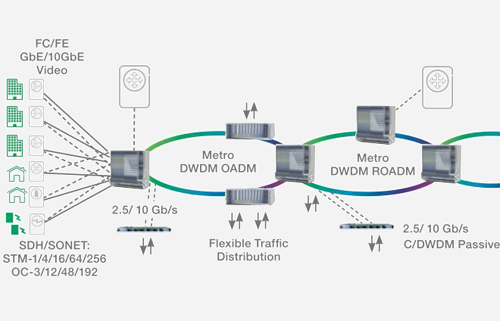What you need to know about 100G
What you need to know about 100G Transporting data was up to 1...
Compatibility guide for Fiber Optic Modules
Compatiblebrand Model TinoutProduct type Product descr...
Pluggable 100GbE CFP,SFP+|XFP and SFP(single Fiber)
Save up to 80 % with compatible transceivers CFP|SFP+, XFP|S...
SFP Definition from Tinout
(Small Form-factor Pluggable) A small transceiver that plugs into the SFP port of a network switch and connects to Fibre Channel and Gigabit Ethernet (GbE) optical fiber cables at the other end. Superseding the GBIC transceiver, SFP modules are also called "mini-GBIC" due to their smaller size. By choosing the appropriate SFP module, the same electrical port on the switch can connect to fibers of different types (multimode or singlemode) and different wavelengths. If the fiber is upgraded,
ROADM Solutions
From Static Pipes to Dynamic Networks
WDM technology has brought more than an order-of-magnitude increase in the amount of bandwidth that can be transported over fiber. Early implementations were point-to-point only. However, while transport networks may be thought of as the roads of the network, the intersection points are also critical-this is where the intelligence lies.
Any Wavelength, Anywhere, Anytime
Today's Optical+Ethernet networks are much more dynamic than in the past and demand greater flexibility. In order to provide the necessary flexibility, Reconfigurable Optical Add Drop Multiplexers (ROADMs) were developed. They allow operators to access any wavelength at any node at any time-replicating the operational simplicity and flexibility of SONET/SDH networks at the wavelength level.

Colorless, Directionless, Contentionless - Flexgrid
State of the art ROADM technology allows operators to not only drop any wavelength at any node and any time, but to also send any wavelengths in any direction (directionless) using any available port on the network node (colorless). This so-called CDC architecture (colorless, directionless, contentionless-any wavelength, any node, any time) is fully flexible and non-blocking. It requires very little technical skill from the operational staff and eliminates the need for meticulous pre-planning. CDC ROADMs are the foundation of a fully automated optical network, and they allow for intelligent interworking with the IP/MPLS technology that rides on top.
Reconfigurable Optical Add Drop Multiplexer (ROADM) adds the required flexibility so that adding WLs or changing the WL destination becomes easy and remotely managed process providing full control and monitoring over the entire high capacity infrastructure.
The basic element of the ROADM is the Wavelength Selective Switch (WSS). The WSS is an active component that performs the actual WL switching and monitoring. Tinout's ROADM offers the ultimate in flexibility and in a low cost WSS technology suitable for core and edge applications. The user can dynamically drop any wavelength to any port and then seamlessly change drop capacity on an as needed basis. The advanced ROADM core WSS component provides a flexible channel plan together with dynamic per-channel power equalization. With its industry leading footprint and switching speed WSS component in tinout's ROADM product is the best wavelength routing solution for core metro and edge networks. Together with OCM (Optical Channel Monitoring), it monitors and balances power across all channels using VOAs array.






